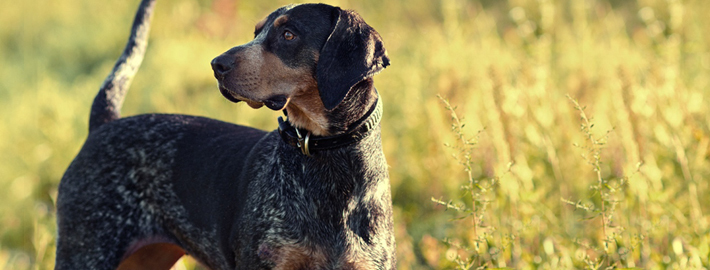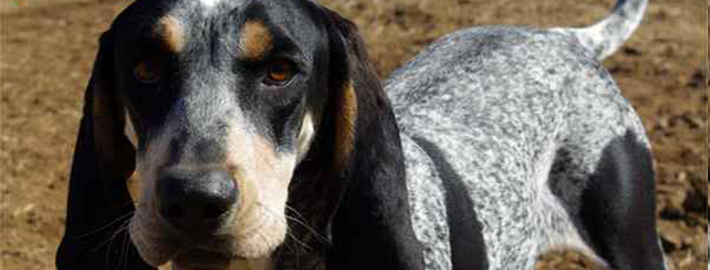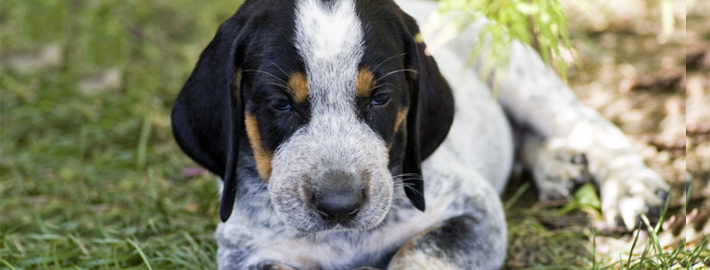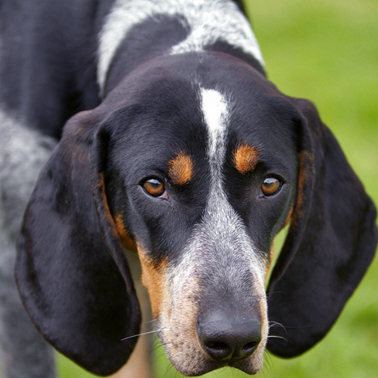What makes the Bluetick Coonhound Unique?
Bluetick Coonhounds have a personality that seems suitable for a personals ad. These dogs are intelligent, sweet tempered, and friendly. Plenty of people also consider these dogs to be a handsome breed.
Breed Groups
Page Contents
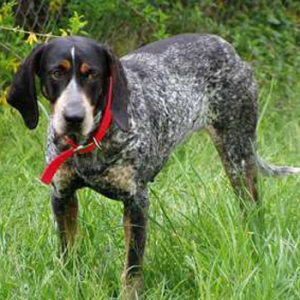
Is the Bluetick Coonhound Right For You?
Bluetick Coonhounds are gregarious, affable dogs but this can vary amongst individual members of the breed. A number are known to be shy or aloof around unfamiliar people. They can also be incredibly playful and make good companions for children. However, families with toddlers or small children may want to adopt a fully grown Bluetick because they are less likely to be overly rambunctious. Members of this breed get along perfectly fine with other dogs and most will tolerate cats.
Prospective owners should definitely note that these dogs are droolers. They are also known to bark and howl loudly, especially if unfamiliar people arrive at their house. These dogs may also actively smell newcomers, a trait which can sometimes be perceived as aggressive but merely the way they choose to greet people.
In 5 Words
- Friendly
- Active
- Intelligent
- Devoted
- Fine Guardian
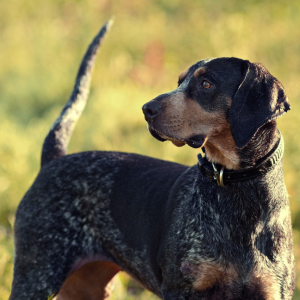
Characteristics
Learn About the Bluetick Coonhound
Description
General Description
Bluetick Coonhounds have wide, domed heads and thin, low set ears. Another breed feature is their long, square muzzles that have a pronounced stop. Their large, dark brown eyes are spaced far apart. The tapered tails found on this breed are carried high. Bluetick Coonhounds have muscular legs and compact feet. Toes on this breed are arched. It is typical for the dewclaws on this breed to be removed.
Size
Females of this breed are much smaller than their male counterparts. However, dogs of both genders typically stand between 21 and 27 inches (53 and 68.5 centimeters) tall and they weigh between 45 and 80 pounds (20 and 36 kilograms) each.
Coat
This breed has short, thick coats. Although their fur is rough when touched, the coat on Bluetick Coonhounds has an appearance that is both glossy and smooth. These dogs are typically dark blue with mottled bodies. Black spots are also found on their sides and back but the ears and heads on these dogs should chiefly be that color. Members of this breed who sport tricolor fur seem to be almost blue speckled but this is a trick of the light due to the fact that the black spotting occurs on a white background. Tan markings may also be present in various locations. American Kennel Club regulations call for more blue coloration on the dogs’ bodies rather than black. Likewise white ticking should be less prominent than blue ticking.
Short History of the Bluetick Coonhound
Crossbreeding of the Grand Bleu de Gascogne and the English Foxhound was thought to have brought about the English Coonhound breed that was created in America during the 1700s. Bluetick varieties were considered to be a specific coloration of the aforementioned breed rather than their own entity. This breed was recognized by the United Kennel Club (UKC) in 1905. During the 1940s, faster coonhound dogs were being produced and Bluetick fanciers didn’t like this new development. They established their own breed which achieved American Kennel Club (AKC) recognition in 2009.
Temperament
For the most part, Bluetick Coonhounds are gregarious, affable dogs but this can vary amongst individual members of the breed. A number are known to be shy or aloof around unfamiliar people. They can also be incredibly playful and make good companions for children. However, families with toddlers or small children may want to adopt a fully grown Bluetick because they are less likely to be overly rambunctious. Members of this breed get along perfectly fine with other dogs and most will tolerate cats.
Trained Bluetick Coonhounds make excellent family members but they do need a while to learn what is expected of them. They are not a couch potato breed and owners should tailor their expectations accordingly. Prospective owners should definitely note that these dogs are droolers. They are also known to bark and howl loudly, especially if unfamiliar people arrive at their house. These dogs may also actively smell newcomers, a trait which can sometimes be perceived as aggressive but merely the way they choose to greet people. Members of this breed have a strong olfactory sense. It goes without saying that they will get into food that is left unsupervised and garbage bins that are not properly secured.
Caring for Your Bluetick Coonhound
General Health
As a generally healthy breed, Bluetick Coonhounds often live between 11 and 12 years. However, there are reports that some members of this breed have been diagnosed with lysosomal storage disease, bloat, and hip dysplasia. Dogs that are used as hunting animals can additionally sustain injuries over the course of their duties. In such cases, prompt medical attention may be needed. Owners should also be vigilant in keeping their pet’s rabies vaccinations up-to-date as Bluetick Coonhounds have been known to tangle with raccoons from time to time.
Care
Daily
These dogs need vigorous exercise on a daily basis. It is recommended that owners take their Bluetick Coonhounds out multiple times a day for long walks.
Weekly
These dogs benefit from being allowed to play in a safely enclosed environment, such as a fenced-in back yard, at least two times a week. Pet owners may also want to brush their dog’s teeth a few times a week in order prevent bad breath and tartar buildup. Regular tooth brushing can also help reduce the likelihood of periodontal disease. It is also a good idea for owners to inspect their dog’s floppy ears once a week for debris and signs of infection. These appendages should be cleaned on an as needed basis.
Monthly
Flea, tick, and heartworm prevention medication is a must for all dogs. These products should be applied on a monthly basis.
Grooming & Bathing
These dogs only need to be bathed occasionally. However, their toenails should be kept clipped to prevent injuries from occurring.
Exercise & Training
Bluetick Coonhounds have the excellent stamina and robust temperament that was needed to help them become superior hunting dogs. Thus, this athletic breed needs both mental stimulation and plentiful exercise to keep them from becoming either neurotic or destructive. These dogs do best in rural environments when kept outside in large, fenced-in yards. Dogs that are in the process of being exercised will need to be kept on their leashes because otherwise they may disappear in pursuit of prey or an interesting aroma.
In keeping with their natural temperament, it is best that owners either use Bluetick Coonhounds for their original purpose of hunting and tracking game or train them to participate in dog sports to keep them active and out of trouble. These dogs are generally obedient when they have been trained. However, hounds don’t always learn quickly and they need patient instruction in order to become skilled at any task. These dogs tend to largely be motivated by food, so owners may want to incorporate treats into their lessons when teaching this breed.

